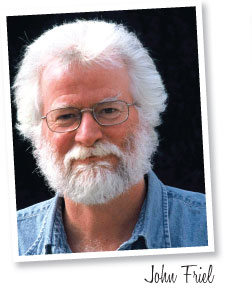8/27/2015
Endings and Beginnings
John Friel

As you read this, the Perennial Plant Association’s national Symposium is long over. As I type, post-conference tours are still prowling around Baltimore.
This year the Association bestowed our highest honor, the Award of Merit, on my ex-employer, Oliver “Buzz” Babikow. You probably just said, “Who?” because Buzz’s name and story are not nearly as familiar as they should be.
Born in 1932, Buzz grew up in the family business, W.E. Babikow & Sons, near Baltimore. Founded in 1875, the rare fifth-generation company is still going strong. We toured it Wednesday.
Buzz started Green Leaf Enterprises in the early 1970s. Needing more space, he moved north to Pennsylvania, where once-prosperous greenhouses were failing as rose and carnation production went south.
By the early 1980s, Green Leaf was a major propagator, shipping annual starters throughout America. Perennials got hot and that’s where Buzz made a major impact: He modernized the propagation of herbaceous perennials.
Perennials were stepchildren of the nursery industry, with propagators sticking big woody cuttings in sand beds. Buzz offered a wide range of perennials in easy-to-use starter trays, so finished-pot wholesalers could do the same. Result: a quiet revolution. With ambitious speculative production—Buzz abhorred empty benches—he created the starter plant spot market, simultaneously exploiting and fueling the perennial explosion.
This is the technology issue, so it bears mentioning that Green Leaf was not high-tech. Its crews were adept at rehabbing and retrofitting, teaching old ranges to nurture new crops.
Among many excellent presentations in Baltimore was a special session, “How Perennials Changed Our World and the Icons Who Made It Happen.” American perennial horticulture began here, with roots reaching back to visionary German plantsman Karl Foerster. Three speakers, including Buzz’s brother Paul, traced the industry’s trajectory from the 1950s to today.
A day later, gifted young hort prof Jared Barnes presented, “Propagating Horticulturists,” comparing the challenges of producing plants to training new plantsfolk. Our future depends on how, and how much, we expose youth to horticulture. Again—echoes of Buzz Babikow, who didn’t just grow plants: He grew growers. With eight locations, he had to.
His brother Paul said, “Buzz surrounded himself with talented people—and listened to them.” He trusted his employees, trained them well and encouraged experimentation. He sent them to early PPA symposia and they returned with new ideas, plants and contacts.
Business owners generally find that some of their best people are content as employees, while others gravitate to entrepreneurism. Green Leaf spawned more spinoffs than a hit sitcom. At least nine successful nurseries, including my employer, were started by growers who worked there.
At last year’s symposium in Cincinnati, an attendee asked, “Where are all the young people?” I asked how many he’d brought along. Young people starting careers in horticulture can’t afford seminars. Their employers must expose them to a backstage look at all this industry has to offer. I pointed that out in this space and issued a challenge/invitation: Bring a young person to PPA. I’ll buy him or her a meal and you a drink.
No one has taken me up on it, exactly, but the fellow who asked that question was Ferenc Kiss, co-owner of Cavano’s Perennials—another tour stop this week. To his credit, Ferenc funded a PPA Foundation scholarship, allowing a hort student to attend this year.
It just occurred to me that I owe Ferenc a drink. Next year, I hope I owe you one.
P.S.: I attended my first PPA in Baltimore in 1987. My tenure on its Board of Directors ended here this year. Bittersweet? You bet.
GP
John Friel is marketing manager for Emerald Coast Growers and a freelance writer.